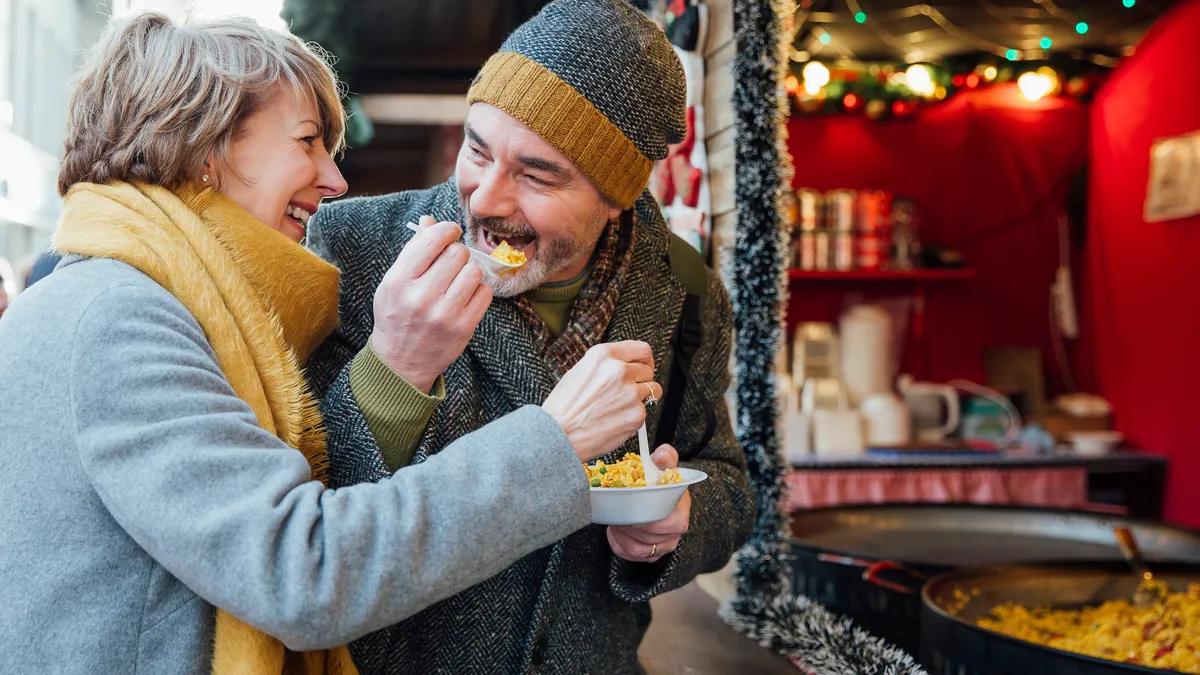Winter weather’s not yet on the radar in most parts of the U.S., but holiday retail sales are well underway.
This is good news for quick-service and fast casual restaurants. More shopping trips mean more consumers looking to grab a coffee at a convenient drive-through, make a quick lunch stop or pick up snacks on the way home to avoid the dreaded “drop after shop.” Forecasters anticipate increased restaurant sales volume for the remainder of 2022,1 a trend we’re already seeing in the growing number of navigations to both sit-down and casual dining destinations.2
To appeal to these on-the-go consumers, though, restaurants will need to build smart advertising and attraction marketing strategies. Here are three ways that they can capitalize on the latest trends to draw in holiday shoppers.
1: Be in the right place at the right time
In-car advertising is a great way to remind consumers that convenient food options are available nearby, catching their attention just as their energy’s beginning to flag and they feel the first pangs of hunger. This enables restaurants to take advantage of local shoppers’ snack-buying impulses exactly when they’re the strongest.
Brand and agency leaders in the restaurant marketing space agree that this tactic works. In a recent survey of these executives conducted by Restaurant Dive’s studioID in partnership with Waze, 83% said that in-car advertising was very or extremely effective in converting on-the-go consumers into in-person diners.
“Particularly during times of economic uncertainty when shoppers want to make every one of their purchasing dollars count, attracting impulse buyers can have a significant impact on your margins,” says Mike Wilson, Head of Industry for Restaurants at Waze. “When your advertising is based on location and time of day, it makes it much easier to reach people right when they need to grab something to eat.”
2: Invest in attractive and efficient curbside pickup and takeout areas
Takeout is an increasingly attractive option for today’s cost-conscious consumers. With grocery prices on the rise, grabbing a meal from a local casual restaurant chain may even be cheaper than dining at home. In fact, grocery prices increased 13.1% [in the last year] whereas food away from home prices increased substantially less than that — at about 7.6%.
With this in mind, navigations to restaurants in the quick-service and casual dining categories were up 3.2% year-over-year in the third quarter of 2022.3 This comes after an even larger year-over-year increase (of 6.1%) during 2022’s first half.4 That the number of visits is still growing is welcome news for the industry, but the decline in the relative rate of increase likely reflects current economic uncertainties and the aftereffects of inflation. Now more than ever, it’s critical to make every visit count.
According to restaurant brand and marketing agency leaders surveyed by studioID on behalf of Waze, takeout and curbside pickup orders were more likely than any other type of sale to be described as “extremely profitable.” Nearly 70% of respondents described takeout/curbside pickup as either “very” or “extremely profitable.”5 Given the impact of existing takeout and curbside pickup options for restaurants, making small upgrades and refinements to these customer conveniences can have an outsized impact on revenues. It’s a way to make guests feel welcome while creating efficiencies that enable faster order turnover and greater sales volumes.
3: Encourage repeat visits by doubling down on loyalty programs
Restaurant marketers are well aware that it’s typically less expensive — and more profitable — to retain an existing customer than to acquire a new one. This old adage is especially relevant during challenging economic times, when consumers may be less likely to try new things.
In fact, respondents to the recent e survey conducted by Restaurant Dive’s StudioID on behalf of Waze reported significantly lower expectations when it came to consumers’ willingness to experiment with new restaurants and cuisines. When restaurant brand and marketing agency executives were asked if they believed that today’s customers were more likely to explore new restaurants while out and about, their perception had fallen 30%.6 In other words, industry stakeholders believe that they’re seeing a resurgence of brand loyalty. After the waves of change that we experienced during the pandemic, it may be that consumers are again settling in with repeat visits to their new favorites.
With this change in mind, it is an opportune moment for restaurants to hone their loyalty programs. After all, encouraging repeat visits is a smart strategy for boosting revenue and Waze’s variety of loyalty targeting options can help restaurants reach new, existing and lapsed customers. Despite economic headwinds, the data shows that there is still plenty of room for restaurants to thrive this holiday season.
Want to learn more about how Waze advertising can help you meet growth and revenue goals? Visit our interactive dashboard to learn about the latest local trends and opportunities.
1 “Holiday sales growth expected to slow this season: report,” Retail Dive, September 2022, URL. Accessed 19 October 2022.
2 “Category Trends.” Waze, Jan. 1, 2022-Oct. 15, 2022, URL. Accessed 19 October 2022.
3 “Category Trends.” Waze, July 1, 2022-Sept. 30, 2022, URL. Accessed 19 October 2022.
4 “Category Trends.” Waze, January 1, 2022-June 30, 2022, URL. Accessed 19 October 2022.
5 studioID survey, commissioned by Waze, July 2022
6 ibid










